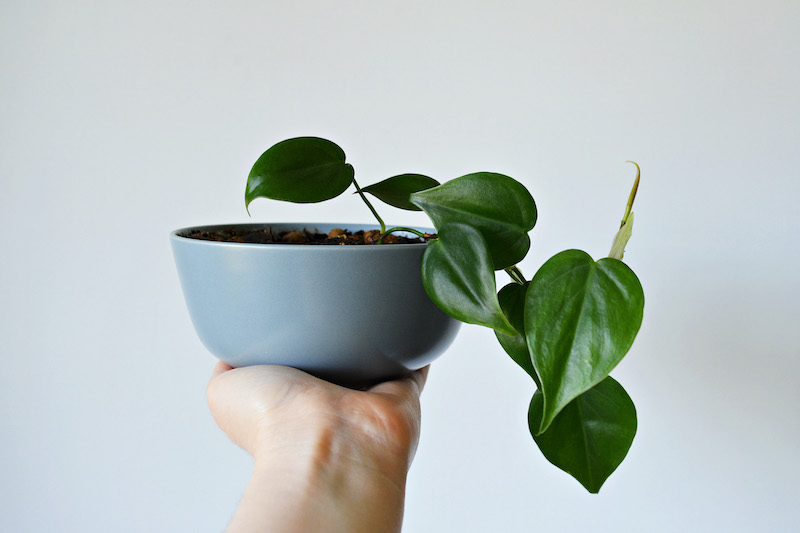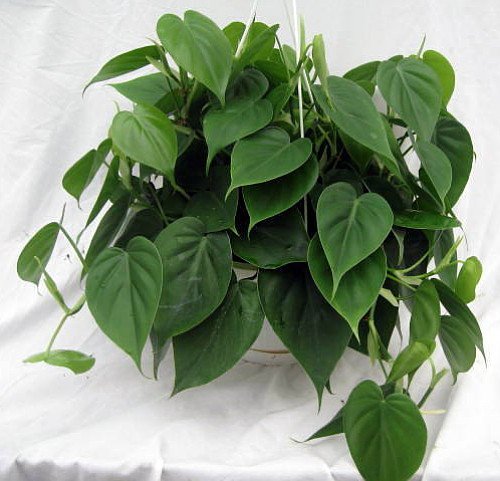The Sweetheart Plant (otherwise known as Philodendron scandens) is a popular houseplant that is perfect for growing indoors in any environment. It is easy to spot because of its heart-shaped, glossy leaves and its ability to climb. Its name has a very romantic meaning. Its species name, Philodendron, comes from the Greek words philo (love) and dendron (tree), making this plant quite literally a “love tree”! Because of its association with love and growth, this heart-shaped leaf houseplant makes a great gift for newlyweds and couples. They can watch their love grow as their plant grows.
While the Philodendron scandens leaves are mostly dark green, they can have a variety of different colors. Generally the mature leaves are dark green and glossy, and young leaves have a bronzy, lightly transparent look. The leaves have the ability to grow up to 10 inches in length, and the stems of the plant can reach 4 feet or more over the course of 10 years. The Sweetheart Plant is an evergreen, meaning it will keep its leaves and its color all year-round.
This heart-shaped leaf houseplant is a climbing plant, and can be grown in pots with supporting poles to help it climb, or trimmed to make more of a shrub. Growing them in a row with trailing vines can make a beautiful living, green curtain. The heartleaf philodendron can also be grown in water.
There are two varieties of the Sweetheart Plant, P.s. oxycardium and P.s. micons. The two varieties look very similar, and are often sold as Sweetheart Plant in most garden centers. Oxycardium has slightly smaller leaves, and micans has a slight purplish red on the underside of the leaves. The Philodendron family contains over 200 different species, many of which are similar to the heartleaf philodendron.

The Sweetheart Plant generally is non-flowering, though mature plants can sometimes exhibit greenish-white flowers-like spathes, particularly in the summer.
Since this houseplant is very adaptable, and can tolerate low levels of light for long periods, it is easy to grow and care for. It requires little maintenance, and will thrive in nearly any environment.
Heartleaf Philodendron Care
Light
The Sweetheart Plant will do well in sunny and shady spots alike. Keep it out of direct sunlight, though. An ideal spot for this houseplant is an east or west facing window. One thing to note about low-light areas is that the leaves spread more than in sunny areas and the colors of leaves are not as vibrant or glossy.
Water
Water your Sweetheart Plant liberally during the spring and summer months, but don’t let it stand in water. Water your plant the right way to make sure the soil is moist, but not soggy. During the winter, water it less frequently, and let the top half of the soil dry out between waterings. It’s easy to tell when this houseplant has too much water: its leaves turn yellow with too much water, and brown with too little.
You can also spritz the leaves of the plant with water and wipe them dry with a soft cloth to remove dust and shine them up.

Temperature and Humidity
This plant likes normal room temperatures. In the summer, make sure the temperature doesn’t rise above 75°F (24°C), and in the winter make sure that the temperature doesn’t drop below 55°F (13°C). If it gets too hot or too cold, just move your plant to a cooler or warmer room. If the temperature is too high or too low it can cause the plant’s growth to slow down.
Fertilizer
Give the Sweetheart Plant standard liquid fertilizer once a month during the spring and summer months. I prefer to do a half-strength mix for indoor plants. During the fall and winter months, you can feed your plant only once every other month.
Pruning
These houseplants with heart-shaped leaves don’t require much pruning, but an occasional haircut can help keep them looking their best and from becoming too big. A good time to prune is when your plant is taking up too much space or is looking long and leggy. The best time to prune is in the spring or fall, though at any time of the year you can give your plant a light trim to remove yellowing leaves and spindly growth. For a major pruning, cut off the longest, oldest stems or any that have yellow or dead leaves. Cut the stems where they meet the main part of the plant, or if you can’t see that, to the soil level.
You can also cut or pinch growth just above the leaf node to neaten up the plant and give it a bushier, healthier growth. This is helpful if you don’t want your plant to climb.
Planting Guide for the Sweetheart Plant
The Sweetheart Plant loves moist soils with high organic matter, particularly compost. They need a loose, quick-draining soil to thrive. Some good choices are orchid pot soil or one part perlite and 2 parts peat with a bit of sand added.
When your plant has outgrown its pot, choose a pot that is no more than 2-3 inches bigger. The best time to repot is in the spring. Make sure to water the plant the day before repotting to reduce stress and make the transition easier. This is also a good time to do some pruning if your plant needs it. After removing the plant, gently separate the roots to stimulate new growth. Once the plant is in its new pot, water it until the water flows freely from the bottom of the pot.
Troubleshooting Heartleaf Philodendron Care
-
- The plant has pale leaves and is not getting new growth
The compost has been exhausted. Repot the plant, or top the pot with an inch or two of fresh compost.
-
- Leaves are yellow and dropping
Too much water. Allow the soil to dry out, and use less water after that.
-
- The plant’s leaves have a black or brown margin
This usually happens when the plant is touching a window. Move the plant back from the window, and make sure to never wet the leaves when in direct sunlight.
-
- The leaves are drooping
The plant needs more water.
Toxicity
The Sweetheart Plant is toxic to children and pets.
Summary of Sweetheart Plant Care

Do:
-
- Keep in lighted area if possible
- Keep in a temperate climate
- Pay attention to the leaves to know how much to water
Don’t:
-
- Place in direct sunlight
- Overwater
- Let your plant get too hot or too cold
Interesting Facts About the Heart- shaped Leaf Houseplant
-
- Like many other indoor plants, this houseplant with heart shaped leaves is a great indoor plant that cleans the air! It filters a variety of air-borne toxins from your home, including formaldehyde, benzene, and trichloroethylene.
- The Sweetheart Plant’s natural habitat is the forests of Central America, where it climbs up trunks and branches of trees. It supports itself from aerial roots which attach to the bark of the trees. In its natural habitat it can reach from the forest floor up to the sunlight above the trees.
Conclusion
If you’re someone who’s thumbs are a little less than green and you are looking for a stunning houseplant, this houseplant with heart-shaped leaves is a go-to. Stop by a garden center and pick one up to give your home some beauty and some nice fresh air. The Sweetheart Plant will become your new love!





